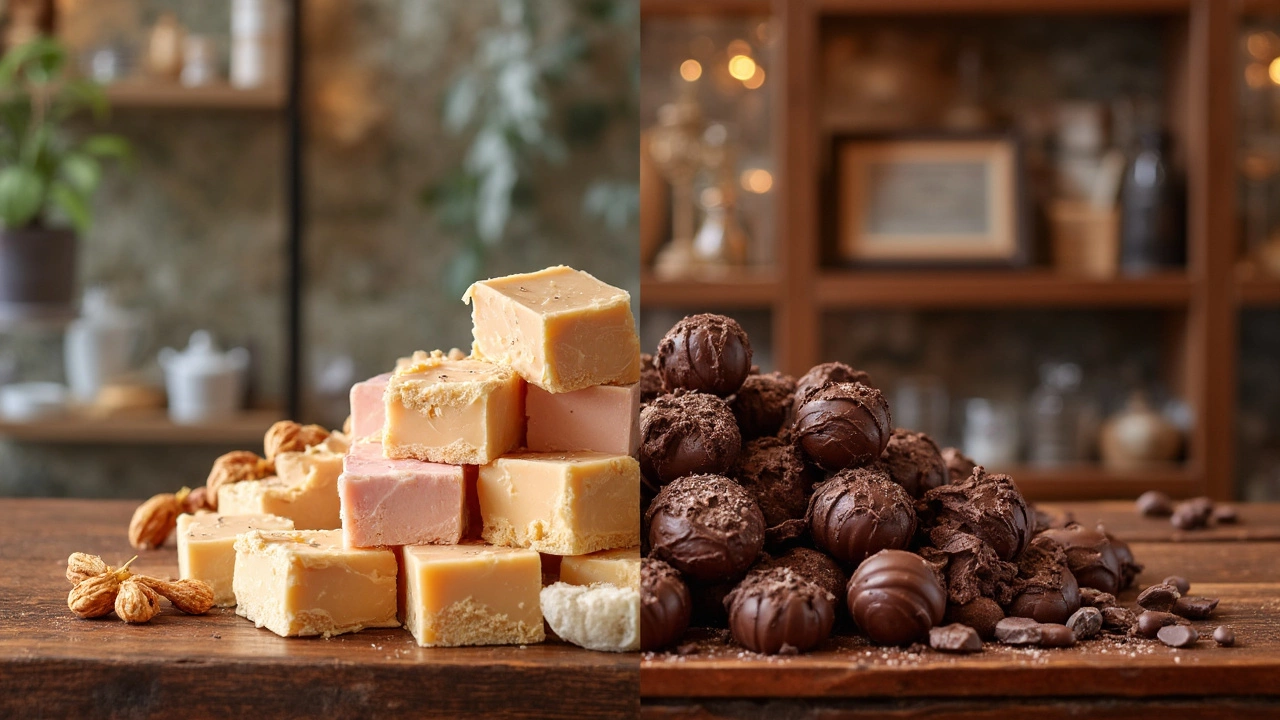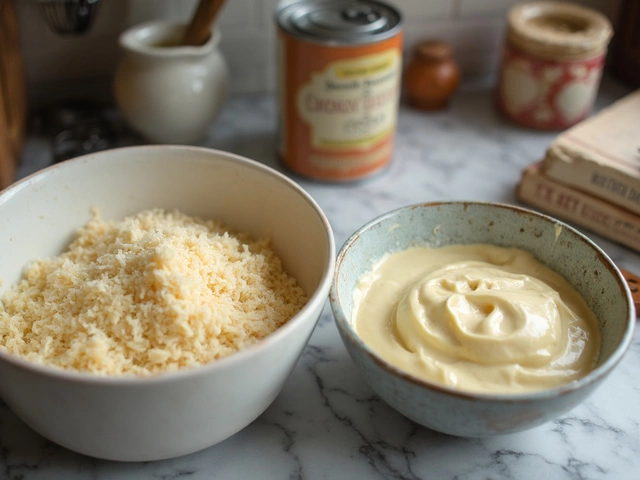
Ever found yourself standing in the candy aisle, debating whether to grab a bar of chocolate or a piece of fudge? It's a sweet dilemma many of us face. But before you make that choice, let's dig into whether fudge is really the healthier option—or if it's just another delicious myth.
First up, the sugar debate. Fudge, with its creamy texture and rich flavor, is no stranger to sugar. In fact, it's a core ingredient. Chocolate, particularly dark chocolate, often boasts lower sugar levels if you choose the right kind. So while fudge and chocolate both satisfy that sweet tooth, their sugar content might tip the scale for health-conscious folks.
What about the ingredients list? Fudge usually involves a mix of butter, cream, sugar, and flavorings—whereas chocolate can range from milk and sugar-laden to pure dark goodness. Each has its perks and pitfalls, and we'll get into that later when comparing their nutrient profiles.
- Understanding Fudge and Chocolate
- The Sugar Dilemma
- Breaking Down the Ingredients
- Calorie Comparison
- Fudge Recipes with a Healthy Twist
- Making Smart Sweet Choices
Understanding Fudge and Chocolate
Alright, let's break down what we're dealing with here. Fudge and chocolate might both hit the sweet spot, but they're quite different in how they're crafted and what they bring to the table.
Fudge is all about that soft, creamy goodness. It's made by heating sugar, butter, and milk, and then beating the mixture while it cools to achieve that smooth texture. The fun part is you can flavor it with just about anything—think vanilla, peanut butter, or even bits of marshmallow.
Now, chocolate starts as cacao beans. These are cleaned, roasted, and ground into a paste called chocolate liquor. Depending on the type of chocolate you want, this can be mixed with milk, sugar, and cocoa butter. You've got your milk chocolate, dark chocolate, and for those who love the sweeter side, white chocolate, which technically isn't chocolate since it lacks cocoa solids.
While fudge is typically higher in sugar, the variations in chocolate mean you can choose a healthier option, like dark chocolate high in cocoa content and low in sugar.
One cool thing to note: while fudge is more of a treat you whip up at home or buy in a candy shop for a special occasion, chocolate is everywhere—used in baking, sneaked into breakfast spreads, or just as a quick snack. Each has its own charm and purpose in the world of sweets!
The Sugar Dilemma
Alright, let's talk sugar—a big player in both fudge and chocolate. If you love sweets but also care about your waistline or your health, you've probably heard sugar getting a bad rap. And for good reason! It's a sneaky little ingredient that can quickly add up to more calories than you'd think. But where do fudge and chocolate stand in this sugary showdown?
Fudge typically relies on sugar to get its rich, smooth flavor and thick, creamy texture. Its classic recipe includes sugar, butter, and milk or cream, melted into a sweet delight. We're talking around a whopping 45-60% sugar content in a typical fudge recipe. It’s almost like sugar in disguise!
Now, moving on to chocolate. It's not all equal here. Dark chocolate, for instance, contains way less sugar than milk or white chocolate. Some dark bars hit as low as 10-15% sugar if you go for 70% cocoa or more. This can be a huge difference if you're keeping an eye on your sugar intake. So, if you're swapping your fudge for chocolate in hopes of cutting down sugar, dark varieties might be your friend.
Here's a quick table to compare their sugar content:
| Type | Approx. Sugar Content |
|---|---|
| Traditional Fudge | 45-60% |
| Milk Chocolate | 50-55% |
| Dark Chocolate (70% cocoa) | 10-15% |
So, what's the takeaway here? If sugar is your nemesis, opting for chocolate could help, especially if you choose the dark chocolate path. But hey, if fudge is too irresistible to pass up, consider moderating your portions or exploring recipes that use less sugar. There are ways to satisfy that sweet tooth without totally abandoning your health goals!
Breaking Down the Ingredients
When you're looking at fudge, it's important to know exactly what goes into making this creamy marvel. The basics are pretty straightforward: you take sugar, butter, and milk—often swapping milk for cream if you're feeling fancy. Add in some flavoring, be it vanilla, cocoa, or something nutty, and you've got yourself a traditional fudge base. Sounds indulgent? It totally is!
What about chocolate, though? Chocolate, especially the milk variety, can pack quite a few bonuses like milk solids and cocoa butter, turning it into a smooth treat. But dark chocolate is where it gets interesting—it's usually just cocoa mass, cocoa butter, and a bit of sugar. Less fuss, more cocoa goodness.
"The simplicity of dark chocolate is its greatest strength and why many consider it the healthier choice," says Dr. Elaine Jacobs, a food scientist at the Sweet Sciences Institute.
Let’s break it down a little further though, what do these ingredients mean for your health? Butter and cream make fudge rich and delicious but also up the calorie count and saturated fat to some degree. Chocolate, on the other hand, varies—milk chocolate tends to have more sugar and fat, while dark chocolate has higher cocoa content and potentially more antioxidants.
Here's a quick glance comparing some key ingredients:
| Ingredient | Fudge | Chocolate |
|---|---|---|
| Sugar | High | Varies |
| Fat | High (butter/cream) | Moderate (cocoa butter) |
| Cocoa | Low to none | Varies, higher in dark |
So, when it comes to picking between these two sweet treats, understanding their ingredient list helps you decide which fits better into your diet goals. Do you go for the richness of fudge or the potentially healthier benefits of dark chocolate? The choice is as diverse as the options you have at your local confectionery store.

Calorie Comparison
Now, we're diving into those numbers that either make us cringe or celebrate—calories. When you're deciding between fudge and chocolate, it's worth knowing which is packing more of those pesky little units of energy.
A standard serving of fudge, let's say about 1 ounce, clocks in at roughly 130 to 150 calories. It's no surprise, given the sugar, butter, and cream it contains. Each of those ingredients adds up in the calorie department.
On the flip side, if you grab a similar serving size of milk chocolate, you're looking at around 140 to 160 calories. Dark chocolate usually edges a bit lower, often coming in at about 100 to 120 calories per ounce, which makes it a favorite for those trying to keep things in check while still indulging in something sweet.
If you're curious about how these treats rack up nutritionally, check out this simple comparison:
| Treat | Calories (per ounce) |
|---|---|
| Fudge | 130 - 150 |
| Milk Chocolate | 140 - 160 |
| Dark Chocolate | 100 - 120 |
So, what's the takeaway? If you're choosing between these sweets, consider how they fit into your overall diet. Fudge might be richer, but a piece of dark chocolate could offer lower calories and a bit of health punch from antioxidants. Choose what suits your taste and lifestyle best!
Fudge Recipes with a Healthy Twist
Craving something sweet but trying to be mindful of health? Let's talk about fudge that's not gonna break the calorie bank. You can have your cake—well, fudge—and eat it too with these healthier recipes. You don't have to sacrifice taste for health; it’s all about swapping a few ingredients.
First off, use alternatives like coconut sugar or maple syrup instead of that giant bag of white sugar you were eying. They’re less refined and generally have a lower glycemic index, meaning they won't spike your blood sugar quite as much.
An easy favorite? Avocado fudge. Yeah, you heard that right! Avocados aren't just for guac. They add creaminess and are packed with healthy fats. Just blend ripe avocados with dark chocolate and a touch of vanilla extract. Pop it in the fridge, and you’ve got a decadent treat that's surprisingly good for you.
Let’s not forget about nuts and seeds. Adding almonds or chia seeds can boost the nutritional content and add a satisfying crunch. Rolled oats are another great way to add fiber—and they make your fudge more filling.
- Melt your chocolate of choice on a double boiler or microwave—go for 70% or higher cacao if you want that health edge.
- Mix in mashed avocado, maple syrup, and a splash of almond milk; blend until smooth.
- Fold in your favorite add-ins like chopped nuts or seeds.
- Pour it into a lined dish and let it cool in the fridge for a couple of hours.
These swaps and tips keep your fudge adventures both delicious and a bit healthier than the traditional versions. Remember, it's all about balance, and these recipes show you can enjoy fudge and feel good about it too.
Making Smart Sweet Choices
Choosing between fudge and chocolate should be more than just about preferences. It can also be about making smart decisions that align with your health goals. Let's break it down to keep things simple and practical.
First off, identify what matters most to you—is it reducing sugar, cutting calories, or maybe finding the purer treat? If lower sugar is your goal, opt for dark chocolate with a high cocoa content. Brands often label their dark versions with cocoa percentages. Look for ones exceeding 70% to minimize sugar intake.
For those focused on calorie control, be mindful that both treats can pack a punch. Typically, fudge is denser and could lead to higher calorie consumption if you're not careful with portions. On the other hand, a small piece of dark chocolate can be quite satisfying with its rich flavor, helping you enjoy your treat without overdoing it.
When it comes to choosing ingredients, making homemade fudge with better-for-you elements can be fun and rewarding. Consider recipes that swap heavy cream for coconut milk or reduce sugar using natural alternatives like honey or maple syrup.
Remember, moderation is key. Here are a few tips to keep your sweet indulgence balanced:
- Stick to small portion sizes. A tiny square can often do the trick without throwing off your dietary goals.
- Consider pairing your sweet with something nutritious. Think a piece of chocolate with a handful of nuts.
- Be mindful of your cravings—are they genuine, or just a way to deal with stress?
Sometimes, our cravings can get tricky. Studies show that over 60% of people report having sweet tooth pangs when stressed. Knowing this, it can help to be conscious not just of what you pick, but also why you're reaching for sweets.
So, whether you’re team fudge or team chocolate, making informed choices based on sugar content, calories, and ingredients can ensure your treats are both enjoyable and sensible.












Write a comment